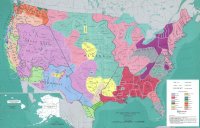Providing Deeper Context in Lessons on Indigenous Peoples
Teachers planning lessons on Native Americans can paint a fuller and more accurate picture with carefully curated resources.
Your content has been saved!
Go to My Saved Content.Every year in November, sometime between Halloween and Christmas parties, “the Indians” arrive in American classrooms for Thanksgiving-themed lessons, reenactments, and bulletin boards. Often, these moments are filled with mythical, two-dimensional, and sometimes offensive references. This year, I’m proposing that we dig deeper into the stories of the peoples who were in North America long before Columbus in the Caribbean, the separatists at Plymouth Rock, or even Leif Erikson and his Vikings vacationing in the comparatively warm winter climes of modern-day Canada around the year 1000.
Although it’s commonplace, especially around November, we really can’t talk about America’s history without looking at the stories of an estimated population of 60 million people living on the land we now call home.
Indigenous Narratives That Provide Historical Context
The stories of the tribes of the Powhatan Confederation: The stories of the 30 Algonquian-speaking tribes living in the Tidewater region of Virginia in 1607 are central to the U.S. origin story. While Jamestown was not the first place that Native Americans encountered Europeans, Old Dominion University’s Christopher Steadman gives context to the stories we know from the perspective of those who came from England to occupy the land [editor’s note: Steadman’s document has been removed from the internet]. These accounts right the narrative that underpins historical representations painting Indians as aggressors rather than the first American peoples who strove to defend and keep their land.
The effects of European occupation on Indigenous peoples: Unfortunately, the attempts of Indian nations to keep their land were largely unsuccessful. Wars portrayed in American history mostly tell of savages attacking settlers but rarely consider the fact that the settlers were the interlopers. This map [editor’s note: the map has been removed from the internet] provides context, showing how European occupation decimated the languages and cultures of the nations of people living on American soil long before colonization. In looking at the map, you’ll notice that, in accordance with our understanding of history, the losses occur east to west, as Europeans marched west to find gold and other resources.
Manifest destiny, edicts, and treaties: Broken and coerced treaties, as well as gunpowder, solidified the rights of nonnative settlers to take over the land. Manifest destiny, a phrase coined by a newspaper editor in the mid-1800s, was the belief that God ordained and blessed the right of Europeans to take over land and convert and civilize “heathens” throughout the West. This “God-given right” was seen as justification for atrocities committed against the nations that inhabited the land.
Additionally, the Indian Removal Act of 1830 further cemented the rights of Whites to the land. In this edict, President Andrew Jackson produced a document claiming benevolence in giving autonomy of rule to the “savage hunters” while guaranteeing that the early American “young populations” could “range unconstrained.” The Indian Removal Act also ensured the forced migration of around 50,000 members of prosperous nations such as the Creek, Seminole, and Cherokee.
The Native American resistance and often-brutal relocation of American Indian nations to new and unfamiliar lands cost them lifestyle, land, livestock, and, for tens of thousands, life itself. The displacement of Native Americans set up the precedent for today’s reservations and gave European immigrants access to tens of millions of acres and the wealth it generated.
Living stories: In spite of the shadow cast by Indigenous historical trauma (IHT)—trauma passed down through generations that shows up in high incidences of disease and substance abuse within populations—the many nations inhabiting North America have survived unimaginable hardship. Many still endure the lasting challenges of high rates of poor health, poverty, and infant mortality, and some of the lowest male life expectancies in the world.
However, their stories do not stop with the stripping away of their sacred lands and tribal identities. Nations like the Chickasaw planned their migration and adjusted, becoming one of the largest and most prosperous nations in the country. Contemporary stories of healing, success, and Indigenous joy can be found on websites and social media platforms, as well as in contemporary museums, literary collections, podcasts, and the news.
Other resources that can help you present your students with accurate narratives that take into account diverse perspectives:
- National Museum of the American Indian: A museum offering online exhibits and free field trips.
- Native Knowledge 360°: Culturally responsive, NCSS-aligned curriculum and teaching resources for K–12.
- Indian Country Today and Navajo Times: Online news publications written from a Native American perspective.
It’s November, almost Thanksgiving, and you may have already done your bulletin board for this year. But I hope, in reviewing these resources, you will find that Native American history is everyone’s history, and the stories you share provide context for your curriculum—not only in November but all through the year.
